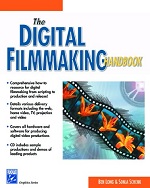libro
The Digital Filmmaking Handbook

Long, Ben
Título: The Digital Filmmaking Handbook
Autor(es): Ben Long, Sonja Schenk
Publicación: Charles River Media, Inc. ; Massachusetts, EEUU, 2000
Idioma: Inglés
Formato: Digital
Resumen: The book guides novice filmmakers through the entire production process while helping experienced filmmakers discover how DV differs from what they already know. The text: includes an in-depth analysis and comparison of the various digital video formats and cameras; details the various delivery formats including the Web, home video, TV, projection, and video; and provides a detailed explanation of how to transfer digital video to film.
Ubicación: 2838-L
Descriptor(es)
1. CINE DIGITAL
2. MEDIOS DIGITALES
3. PRODUCCION
4. TELEVISIÓN DIGITAL
Autor(es): Ben Long, Sonja Schenk
Publicación: Charles River Media, Inc. ; Massachusetts, EEUU, 2000
Idioma: Inglés
Formato: Digital
Resumen: The book guides novice filmmakers through the entire production process while helping experienced filmmakers discover how DV differs from what they already know. The text: includes an in-depth analysis and comparison of the various digital video formats and cameras; details the various delivery formats including the Web, home video, TV, projection, and video; and provides a detailed explanation of how to transfer digital video to film.
New video technology makes it possible to produce Hollywood-quality features, documentaries, training films, and a variety of other productions at a fraction of the cost of traditional film production. To master these digital tools or production, producers need to understand how to integrate these technologies with the traditional filmmakers' resources. If you are interested in, or are currently producing digital features, documentaries, or training material, everything you need to know about digital hardware, software, scripting, production, postproduction, and editing is included in this comprehensive resource. The book guides novice filmmakers through the entire production process, (covering both Windows and Macintosh platform issues), while helping experienced filmmakers discover how DV differs from what they already know. It's not just about video on your desktop, it's about using your desktop to create productions that can be distributed on the web, home video, broadcast television, projection or video including NTSC, PAL or DTV. The text: includes an in-depth analysis and comparison of the various digital video formats and cameras; details the various delivery formats including the Web, home video, TV, projection, and video (NTSC, PAL or DTV); and provides a detailed explanation of how to transfer digital video to film (including sample QuickTime movies of transferred footage). The CD-ROM includes sample productions to use in the learning process, demos of leading products, and other supporting files for the information covered in the book.
Review: The Digital Filmmaking Handbook's title is something of an oxymoron, since this very thorough book covers everything you ever needed to know about filmmaking production, from concept to screening. The only missing element is film itself. Film and video production is in transition. Film and analog videotape are rapidly approaching the end of their technological life, being replaced by digital videotape and digital cameras. You can buy computers that connect to DV cameras and edit DV tape just about anywhere, and they cost only slightly more than an entry-level computer. So The Digital Filmmaking Handbook is for anyone buying into the DV revolution who wants to do more than shoot home movies of the kids. It's for filmmakers young and old, pro and hobbyist, who want to learn to shoot, edit and make great movies. Unlike traditional filmmaking books, in which only the camera and some audio and editing equipment are addressed, part of this book approaches the medium from a computer hardware and software perspective. Numerous hardware issues such as choosing the components for an editing workstation, the kind of digital video camera to use, selecting editing and audio software, and various output formats are discussed. Also, there are chapters on effects, making video look like film and digital titling. The book never strays from speaking to filmmakers rather than filmmaking gear buyers. Everything from preproduction tasks such as scripting, storyboarding and budgeting, to production tasks such as set preparation, lighting, filming (sans film) and sound recording, through final editing, colour correction, titles and output is explained. Filmmaking is heavily dependent on technology, and each of these subjects is well covered. Chapters on audio, for example, include selecting microphone types, the differences between mic types, how to connect them to a DV camera or synchronise the audio in post production, how to control sound levels and so on. The chapter on editing reflects the experience of the authors. Films are understood through their own language, and how scenes are edited determines the dialect of that language. Techniques such as matching screen position, matching emotion and tone, matching action, when to use pauses and overlapping edits, and the effect of pauses and pull-ups (shortening a scene) are defined and justified. If you can't get into NYU's film school, or even if you can, The Digital Filmmaking Handbook is a worthy reference to keep at your fingertips. --Mike Caputo, Amazon.com About the Author: Ben Long (San Francisco, CA) is a writer, producer, videographer, and the author of the best-selling title Complete Digital Photography, Third Edition as well as the first two editions of The Digital Filmmaking Handbook. Sonja Schenk (Venice, CA) is a freelance producer and film video editor who has worked on a number of popular television shows and movies. She is also the co-author of both earlier editions of The Digital Filmmaking Handbook.
Ubicación: 2838-L
Descriptor(es)
1. CINE DIGITAL
2. MEDIOS DIGITALES
3. PRODUCCION
4. TELEVISIÓN DIGITAL


 COMPARTIR
COMPARTIR